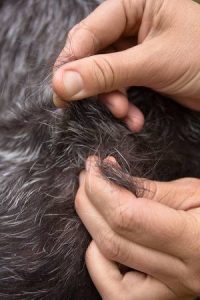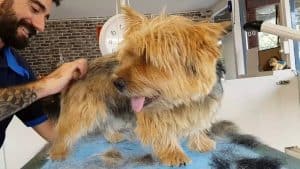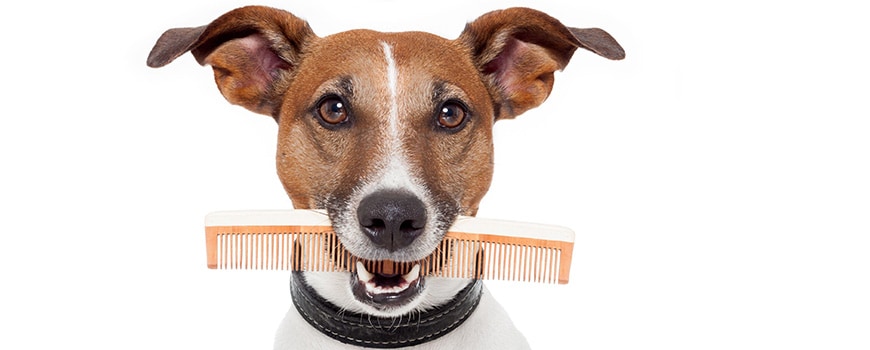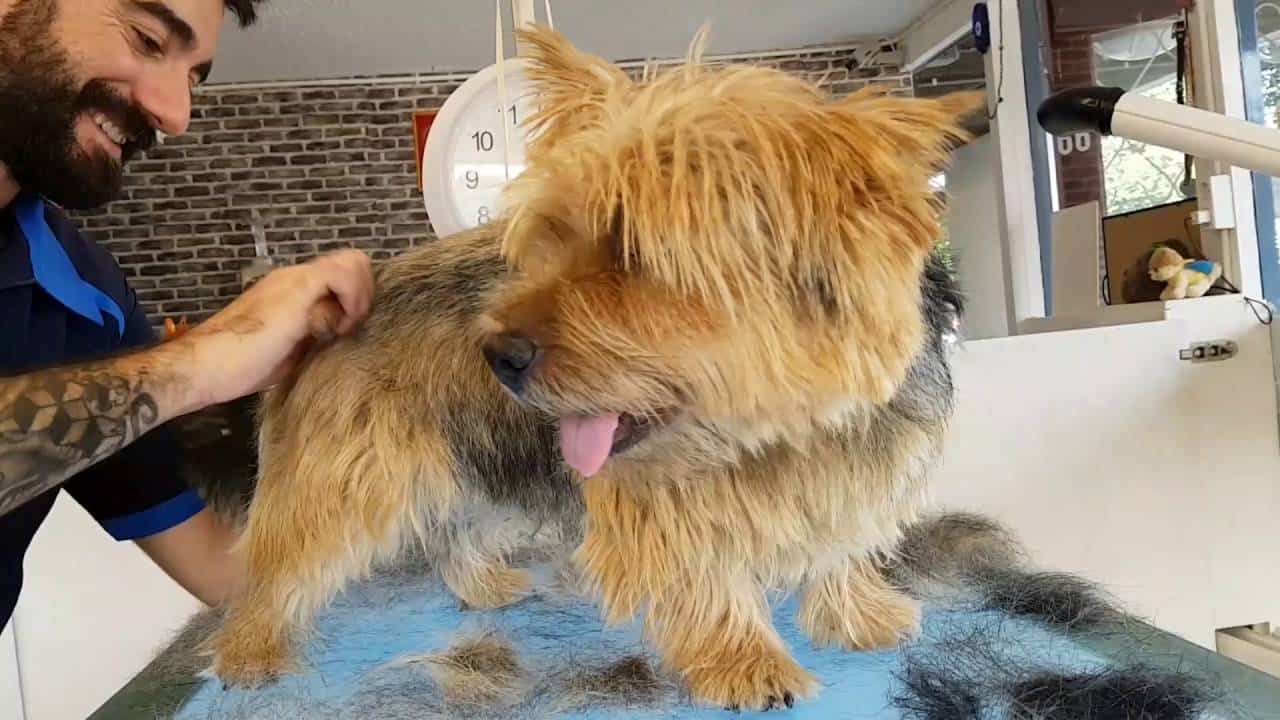Many people ask; what’s the difference between plucking or stripping your dog’s coat? Whilst the terms plucking and stripping are often used interchangeably, a distinction can be made inasmuch as stripping is achieved with the aid of a tool known as stripping knife, whereas plucking is achieved by extracting the hair with the fingers.
You need to assess the condition of the coat and your own physical ability before you decide which method to use. If it is done with care, stripping with tools can be as effective as hand plucking, but if it is done badly the coat will look awful and will be very problematic to maintain.
You must choose and perfect the technique that suits you best, and make your own decisions as to the tools and aids that you use to help you.
Coat Preparation
The coat is more easily plucked or stripped if it has not been washed. A clean coat is soft and glossy and traction to hold the hairs is therefore more difficult to obtain. If the dog has an excessively greasy coat, it is better to wash the coat about three or four days before you intend plucking or stripping it so that it can regain its texture.
It may also be advisable to speak to the dog’s vet. An overly greasy coat is not normal and, whilst there may be little evidence of skin sores or trauma, the grease may indicate an underlying problem.
In most cases it is not necessary to bath the dog after it has had the coat plucked or stripped because the dirt is removed with the hair. The decision to bath is up to the individual.
Hand Plucking
Hand pluckin g is generally considered to be the best method as the desired coat can be removed from the roots with little damage to the individual hairs if you are only using your fingers. If the coat is ready to be removed there should not be any discomfort to the dog but the groomer may experience sore fingers or finger muscle strain if the job is a lengthy one.
g is generally considered to be the best method as the desired coat can be removed from the roots with little damage to the individual hairs if you are only using your fingers. If the coat is ready to be removed there should not be any discomfort to the dog but the groomer may experience sore fingers or finger muscle strain if the job is a lengthy one.
Your first attempt at plucking is likely to take you many hours, and your hands and forearms will no doubt ache for several days but do not let this discourage you. You may want to spread the job over a couple of sessions.
If you do, do not leave it too long between sessions as the coat is continuously growing and even a week may make a difference when it comes to plucking the dog for his next trim – some hairs will be ready to be removed and some will not! Split your sessions over a couple of days at the most.
Building up muscle strength in your hands and forearms takes time, but with practice you will speed up and gain confidence. It is well worth the effort.
Not only is stripping and plucking beneficial to the dog, it has a commercial advantage: it does not use electricity and no tools other than perhaps a stripping knife so there are very few maintenance overheads.
A skilled groomer can hand strip a dog in almost as little time as it takes to groom by clipping, and can charge a lot more money for the service. Many groomers have little desire to learn scissor and clipping skills and have built their entire businesses on plucking and stripping only.
It is not essential but it is easier to start to learn plucking on a smaller breed. A Border Terrier is a good candidate as this breed usually has a slightly longer topcoat; when it is ready for removing, the coat will blow and start to curl and separate into strands.
Since almost the entire topcoat is removed with only a minimum of styling to be done on the face, styling mistakes are not easily made. The topcoat comes out cleanly and the difference in effect between plucked and unplucked is satisfying to see and encouraging to reflect on. Another small breed to start with would be a Wire Haired Dachshund.
To check if the coat is ready, there is no need to brush or comb the coat unless you want to. Turn the dog so that he is facing away from you, and take one of the strands between your thumb and index finger. Pull gently towards you in the direction of coat growth and the strand should come away easily with very little movement of the skin.
Note that the whole of the hair length will have been removed; in many cases the withered “bulb” at the base is just visible. If you hold the hair too far down the shaft, you risk pulling out the undercoat as well as the dead topcoat. Not only does this hurt the dog, but the skin will become sore and the dog may end up with bald patches.
Although your main tool is your fingers, you can get more grip on the coat with the help of chalk or fuller’s earth. But bear in mind that you are using chalk or fuller’s earth because the coat has been washed and it is too soft for you to get a grip, not because the coat is not ready and you need to grip harder to pull it out. This is when problems occur and hand plucking becomes cruel.
Also remember that if you put chalk into the coat, you must get it out by bathing. Chalk soaks up moisture from the skin and dries hard like clay, causing all sorts of problems.
Hand Stripping
You may  want to consider stripping as an option if you have restricted movement or pain in your fingers. Stripping with a knife will be easier for you, and may be quicker. It may also be an option if the hair length is very short and difficult to get hold of, particularly on the top of the head and on the pinna. If it is done properly, you will not cause damage to the coat.
want to consider stripping as an option if you have restricted movement or pain in your fingers. Stripping with a knife will be easier for you, and may be quicker. It may also be an option if the hair length is very short and difficult to get hold of, particularly on the top of the head and on the pinna. If it is done properly, you will not cause damage to the coat.
The disadvantage of stripping with a knife is that if the knife is used incorrectly, the blade can cut the coat, in which case, you may as well have saved yourself the effort and used clippers because the effect will be the same. The coat has not been removed from the follicle and the density of the coat has not been reduced.
Stripping knives are available in many designs and are graded from fine to coarse so, if you intend to strip rather than pluck, you will need to experiment with the different types and their effects.
When you are using a stripping knife, it is unlikely that you will need to use chalk, fuller’s earth or finger cots because the soft pad of your thumb grips the knife blade sufficiently.
How to Use a Stripping Knife Correctly
Use a well-worn knife so the cutting edge is less sharp and less likely to cut the hair. Once you have the hair between the blade and your thumb, draw the knife towards you without turning your wrist or flicking your hand; this will withdraw the full length of the hair.
If the knife is used purely to aid traction with the coat, using a straight wrist action when pulling prevents the teeth of the knife turning and cutting into the coat. If you twist or flick your wrist as you pull, this results in the hairs catching between the teeth of the tool and being cut.
Practice on a small area that is not easily visible until you have mastered the technique. Check your work to make sure that you have removed the entire length of the hair, and that you have not cut the hair along the shaft.
In some areas, for example under the eyes, and for layering a coat a stripping knife is used with a flicking wrist action. This allows the blade to cut and shape the coat by altering the length gradually so that the coat holds the style you wish to achieve.

